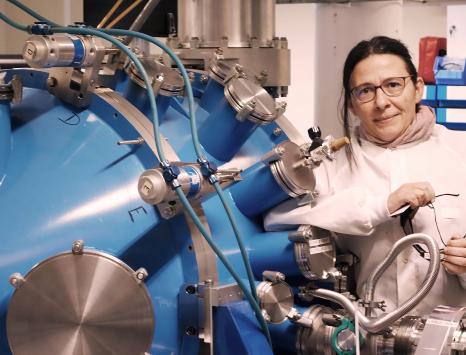
Sophie Kazamias: Compressing the infinitely powerful
Sophie Kazamiasis is a professor at Université Paris-Saclay and deputy director of education for the Graduate School of Physics. A graduate of ‘École Polytechnique’, this physicist has dedicated around 20 years to the Laserix platform, of which she is currently the scientific officer. Laserix namely hosts the PALLAS project by the Irène Joliot-Curie 2 Infinite Physics Laboratory (IJCLab – Univ. Paris-Saclay, CNRS, Univ. de Paris). It is one of five French particle accelerators using laser technology.
The Laserix platform, which belongs to the family of intense lasers, uses terawatt-like power which can accelerate particles: “The laser creates extraordinary accelerating fields in plasma. This means that we don’t need buildings of hundreds of metres long to house the metal cavities used in current technology, because the accelerating fields are a thousand to a million times bigger,” explains the platform’s scientific officer. This very promising and innovative technology has received considerable French and European investment. Funded by a planning agreement between national and regional governments (CPER) from 2003, Laserix has, since then, received significant financial help from Université Paris-Saclay.
The best in the world in its class
Sophie Kazamias works in the Accelerator, laser and applications (ALEA) team of around 10 people. Her role is to identify interesting scientific trends in the long term so that the laser unit remains useful, legitimate and funded. “The way the instrument works means that it has to be constantly improved to ensure that it remains state-of-the-art, the best in the world in its class. This is a lot of work,” admits the researcher. “We need to keep our knowledge up to date to be able to understand the technical advances to be implemented on site, how to fund them and how to develop scientific projects.” This research, which is very costly, means that continuous efforts must be made to find funding to be able to meet the challenges that will allow it to remain competitive in European and international contexts.
Laser-Plasma and X-Rays
Sophie Kazamias’ research is split between launching the prototype of the laser-plasma accelerator as part of the PALLAS project and ultra-intense and ultra-short light sources in the field of X-rays (femtosecond and attosecond lasers). “In this case, this means flashes of light that are currently amongst the shortest in the world.” This research is often done in conjunction with the French industrial groups Thales and Amplitude, which are world leaders in intense lasers, and start-ups like Imagine Optic, which is close to the School of Science at Université Paris-Saclay.
In 2013, the team did a world first: “We were able to amplify a harmonic beam in a Laserix plasma into a solid target, a result that we have been waiting for 10 years”, remembers the physicist. More recently, the team has managed to create and define a vortex: a whirlpool of XUV light that rotates 25 times faster than in infrared.
In addition to its own work, the ALEA team also collaborates on research projects that need the laser beam to be used for some time. The Laserix Scientific Committee first undertakes a scientific, technical and financial review of the project, before approval from institutional funding organisations (French National Research Agency, European Research Council, Ministry of Higher Education, etc.). “When the project has been approved, we commit to providing part of the laser beam time in return for scientific collaboration or a financial contribution,” says Sophie Kazamias. “It is our responsibility, however, to guide teams whose projects don’t necessarily need such a powerful laser.”
Passionate about physics
Sophie Kazamias first physics lesson in high school was a revelation: she wanted to become a physics teacher. After a scientific baccalaureate and 2-year preparatory courses for a competitive exam, she was admitted to ‘École Polytechnique’ in 1996, and thus began her love of lasers. “I liked this blend of quantum physics and technology,” says the researcher, who considers herself to be an experimenter. She undertook a thesis about harmonic generation of femtosecond lasers that she carried within the Applied Optics Laboratory (LOA) under the supervision of Philippe Balcou, and finished it in two years, in 2003. Very quickly, she was hired as a lecturer at Université Paris-Sud (now Université Paris-Saclay), at the age of 25, to lead Laserix’s scientific work. She became a professor in 2016.
The pleasure of sharing
“To teach physics in a dynamic way, you have to be part of it, as close as possible to how knowledge changes,”says Sophie Kazamias. She teaches physics to students in their third year of the undergraduate degree, and to first-year master’s in physics students, for whom she developed a module about laser-plasma acceleration. This academic also founded the 2nd year of master’s degree GI/PLATO (Plasma, laser, accelerators and tokamaks) six years ago, which is part of the Erasmus Mundus LASCALA master’s degree that she also developed. “I see my job as identifying the aspirations, psyches and skills of young people to make them happy through physics. I help to guide them to where they will flourish most and be most useful to advancing physics.”
As a member of the Femmes et sciences (Women and Science) association, Sophie Kazamias regularly gives talks in secondary schools to give young girls a taste for science, in particular physics, which is often judged to be either too theoretical or too technological. “On the contrary, I encourage them to go into sectors where there are fewer women. This is precisely where their status as women can make a difference. Their involvement in a research team is a plus. The environment is automatically different.”
A Graduate School of Physics with an international outlook
In 2020, Sophie Kazamias was appointed deputy director of education for the Graduate School of Physics at Université Paris-Saclay and for the physics master’s degrees. She intends to develop a comprehensive international appeal strategy. On the agenda: scholarships to welcome foreign students, the creation of a second Erasmus Mundus master’s degree in quantum physics, QUARMEN, and bringing together the first year of the General Physics master’s degree and master’s degrees taught in French. “I am trying to work in a well thought-out, coherent and harmonious way,” concludes the researcher. “Above all, I feel that I must guarantee the quality of the master’s degree in physics at Université Paris-Saclay.”

